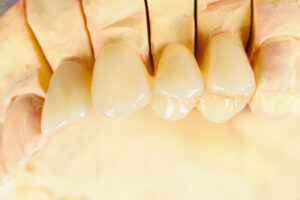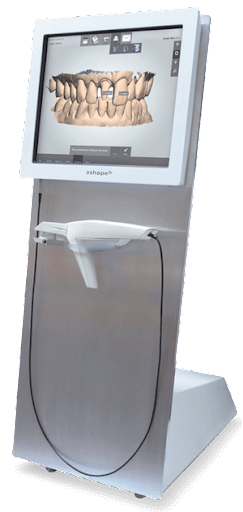Zirconia, an extraordinary material widely used in dentistry for crowns and bridges, has a captivating history that traces back to its Arabic and Persian roots. The term “zirconium” finds its origins in the Arabic word “Zargun” (meaning golden – a fitting description considering its radiant color). This Arabic term derives from the Persian words for “zar” for gold and “gun” for color. Zirconium – an element occurring naturally – possesses an atomic number of 40 and can be found as the mineral zircon in nature.
Through purification, zirconium is transformed into a silver-colored metal that shares corrosion-resistant and titanium-like properties. In combination with oxygen, it forms zirconia – a remarkably robust and biocompatible ceramic material. Although zirconium’s discovery dates back to the 18th century, it was not until much later that its potential in various fields – including dentistry – was fully recognized.
Unlocking the Secrets of Zirconia’s Potential

The initial discovery of zirconium in the 18th century was a momentous occasion, brought to fruition by the successful extraction of zirconium oxide from zircon (courtesy of a transparent gemstone used by a talented German chemist). Subsequently, a Swedish chemist became the first to isolate metallic zirconium. But for approximately 150 years following these breakthroughs, zirconia remained primarily a curiosity – limited to applications like the production of heavy-duty bricks and special glass with exceptional refractive properties.
Zirconia’s Biomedical Advancements
in 1969, the biomedical properties of zirconia were subjected to the first scientific study. It shed light on zirconia’s potential in various fields. This groundbreaking research laid the foundation for further exploration facilitating a groundbreaking discovery in 1972.
Scientists found that alloying zirconia with oxides had the ability to stabilize its tetragonal modification. This led to the development of ceramics with unparalleled crack resistance. These advancements opened new doors for zirconia’s application – especially in the realm of healthcare.
Zirconia Revolutionizes Dentistry
The introduction of zirconia in dentistry marked a turning point in restorative materials – surpassing earlier all-ceramic options by meeting the demanding requirements of both superior strength and exceptional aesthetics. What’s more, zirconia offered a metal-free alternative for patients with metal allergies. That makes it a popular choice over alumina restorations. The dental applications of zirconia include the manufacture of:
- Zirconia dental posts
- Zirconia crowns
- Zirconia bridges
- Zirconia implants
- Zirconia abutments
Orthodontics – Zirconia Beyond Dentistry
Zirconia has also found applications in orthodontics – particularly in the production of brackets. While zirconia brackets offer cost advantages over alumina ceramic brackets, the opacity compromises aesthetic appeal. Nonetheless, zirconia brackets showcase:
- Favorable frictional characteristics
- Reduced plaque adhesion
- Satisfactory bond strength
Get Your Zirconia Crowns, Bridges, Abutments, and More at Next Dental Lab
Zirconia’s journey from its linguistic origins to its versatile applications in dentistry has been nothing short of remarkable. With its exceptional strength, biocompatibility, and aesthetic qualities, zirconia has undoubtedly revolutionized restorative dentistry. It offers patients optimal solutions and practitioners’ innovative tools. As research and technological advancements continue to unfold, the incredible story of zirconia in dentistry is far from over-promising a future of ever-improving dental care.
At Next Dental Lab, we employ the latest materials and technologies in everything we do, including zirconia crowns, bridges, abutments, and more. Contact us for more information.

